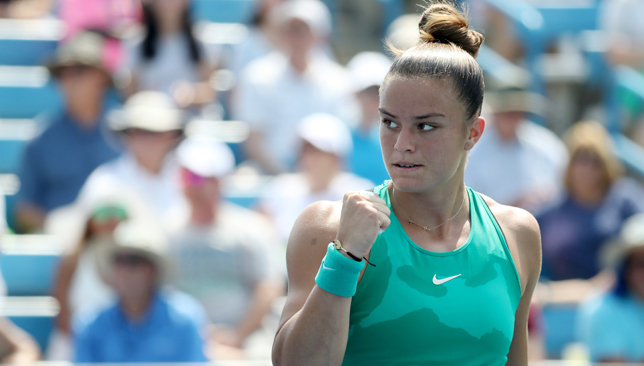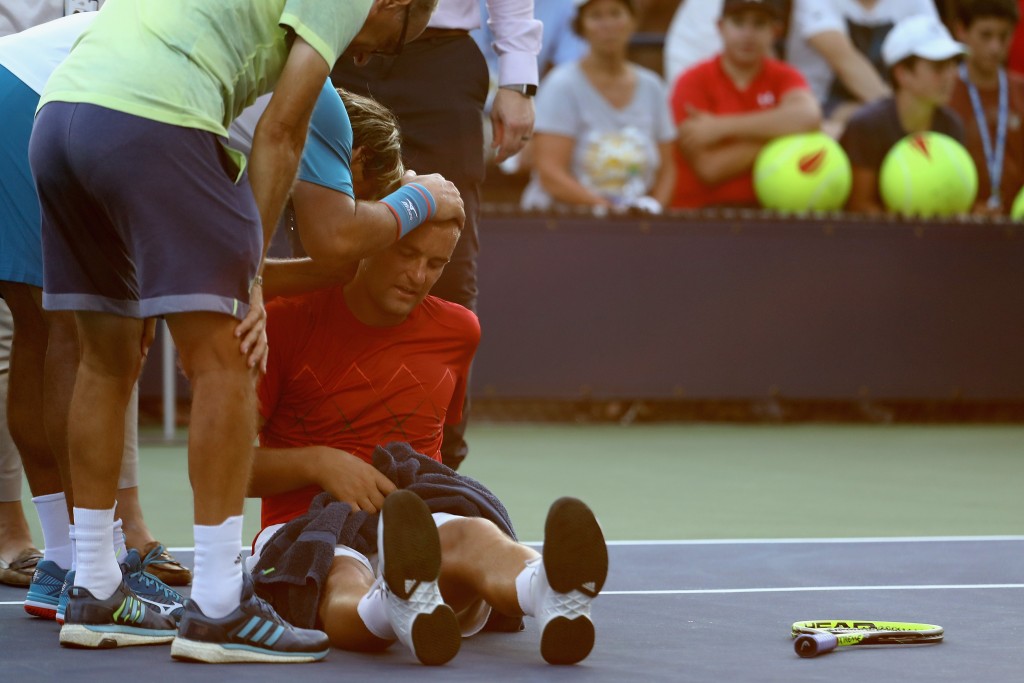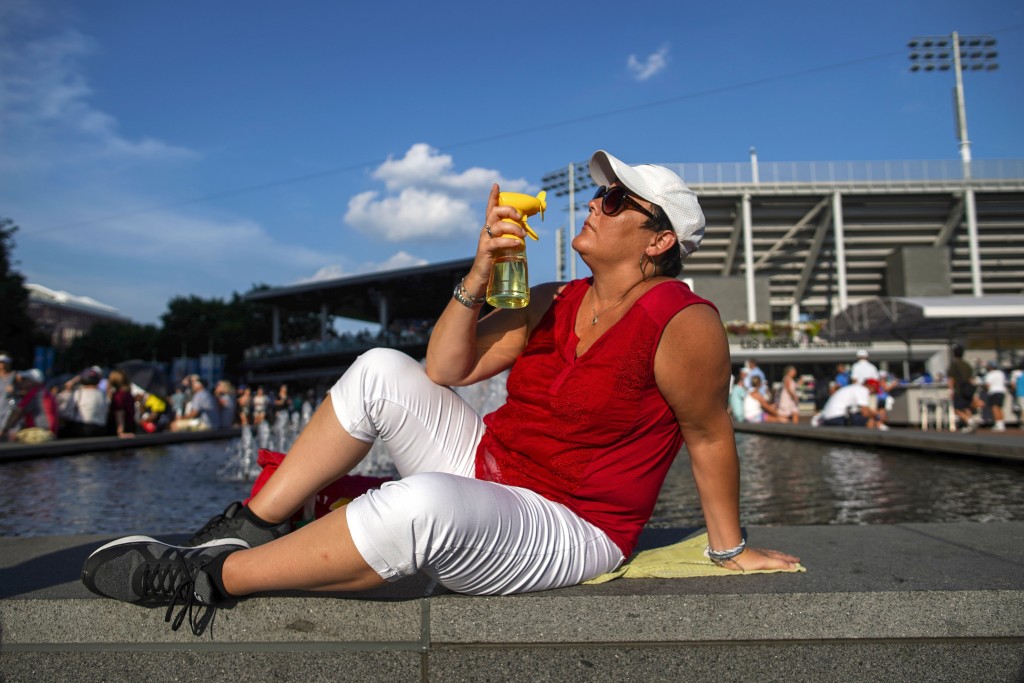Six retirements in men’s matches, Mikhail Youzhny helped up from the ground and escorted by medics off the court – walking backwards for some reason – Novak Djokovic and his opponent taking mid-match ice baths side by side, Alize Cornet needing assistance in the shower… The heat certainly wreaked havoc at the US Open on Tuesday.
Temperatures in Queens, New York soared to nearly 40 degrees and ESPN reported that it was 54 degrees on the court with 46 per cent humidity.
Five of the six retirements in the men’s draw were heat-related (Youzhny, Ricardas Berankis, Leonardo Mayer, Filip Krajinovic, Stefano Travaglia), and many players voiced their concerns over unsafe playing conditions.
As opposed to the women’s Extreme Heat Rule that has been in place for years, a men’s heat policy was implemented for the first at the US Open on Tuesday, allowing the men to take a 10-minute off-court break after the third set.
Still casualties were aplenty and the stories from the players painted a rough picture.

Maria Sakkari feels inspired by Stefanos Tsitsipas, is ready to soak up Greek support at US Open
Youzhny was playing the very last Grand Slam match of his career, and it ended with him cramping and retiring against Marcos Baghdatis in the fourth set.

Malek Jaziri couldn’t sit down for his post-match interview because he was still cramping nearly an hour after his three-set defeat to Pablo Carreno Busta.
“My feet were literally burning from the side and the bottom inside my shoes from the insane heat on the court,” the Tunisian told Sport360. “I really considered retiring after the second set but luckily the temperature dropped a bit in the third so I pushed through it. I felt awful on the court, it was really tough.”
Berankis, who had to retire from his first round against Chung Hyeon with heat illness, believes matches should be canceled under such conditions but the Lithuanian doesn’t have much faith that will officials will listen to his complaints.
“Nothing will change until someone dies,” he told Tennis.com after his match.
Mayer reportedly said the same thing in Spanish to ESPN and called for ditching the best-of-five format at the Slams.
But it wasn’t just the men who suffered. Aleksandra Krunic, who came through a three-set win over Timea Bacsinszky, described the conditions as “brutal” and that other players suffered from the extreme weather.
“I saw Alize Cornet after the second set, she went to the bathroom in the locker room. She went to shower and she was breathing so heavily, I thought something happened, so I went in her shower, I’m like ‘Girl, what happened to you?’ And she’s like (gasp) ‘I can’t, I can’t’. I brought her an ice towel and stuff, it’s terrible. It really lowers the level of tennis,” Krunic told Sport360.
When Cornet returned to the court from the 10-minute break because the heat rule was in effect, she realised her shirt was worn inside out. She went to the back of the court behind the baseline and switched it around quickly but was given a code violation by the umpire for briefly taking her shirt off and revealing her sports bra.
Alize Cornet came back to court after 10 minute heat break. Had her fresh shirt on back to front. Changed at back of court. Got a code violation. Unsportsmanlike conduct….. 😳
But the men can change shirts on court. https://t.co/sCN4KDXYTb— judy murray (@JudyMurray) August 28, 2018
Meanwhile, Krunic said she was focused more on the heat than on the actual clash with Bacsinszky. She felt she played the match on “auto-pilot” and was praying for her Swiss opponent to miss.
Krunic agrees with Berankis and believes there should be strict policies for both the men and the women that halt play altogether in extreme temperatures.
“I think if we’re canceled because of the rain or whatever – we even have tournaments in the ITF in France where the temperature is about zero indoors. And a lot of girls had their muscles torn because it’s zero degrees. We’re professional athletes and we do everything to get ready for the heat but we still have a human body, we’re not machines,” said Krunic.
“I definitely agree with Ricardas, that something should be done, there has to be a limit of heat and humidity and over that limit, like today, whatever the temperature was and very humid, and this is rubber, it’s much hotter, I think the matches should be played from 4 or 5pm. We have to wait until the temperature lowers.”
Krunic also noted that playing matches under these conditions reflects poorly on the sport.
“Maybe they’ll have some retirements in the second round because guys can’t recover, or girls. I think it’s very important to keep the level of good tennis. I think for the crowd especially with all the tickets, they pay a lot of money to come and watch us and if we can’t provide them with good level of tennis it’s not good for our sport. We can’t do it because it’s too tough. I think they should consider doing something about it because it’s just really brutal out there,” she said.
“I think first four rounds [of a Slam] at least shouldn’t be played best-of-five because that’s not for humans really. Because I think it also drops the level of tennis. Guys play good two sets then they drop the third set. I know the crowd has been saying ‘I’m going to go watch from the third set’ because they just don’t want to sit there for so long. And I really feel for these guys.”

Nick Kyrgios, who was grateful to play during the night session when the sun had already set but still said it was very hot, called for the implementation of an extreme heat rule on the men’s tour and emphasised that tennis ultimately an entertainment business that should showcase its best product.
“The heat can become dangerous at times. I don’t think we had a heat rule. We like made one up today, right?” he said after his four-set win over Radu Albot.
“That’s just ridiculous. Honestly I think we should have a heat rule. It’s not healthy for players to be out there, and getting dizzy and stuff. Not only for the players, the ball kids out there. There should be definitely a heat rule looked at and put into place. I think the players should – we’re the ones playing so…”
The Australian added: “The spectators aren’t going to watch if it’s that hot. They’re not going to be out there. There was still a lot of fans out there but at the end of the day not as many people are going to rock up to watch if it’s that hot. And it’s pretty tough for the players.”
Djokovic and Marton Fucsovics both struggled on Arthur Ashe stadium during their first round, and at times it looked like neither one of them would last the whole match.
Djokovic on what he did during the 10-minute break after the third set: ‘Marton and I were naked in the ice baths next to each other… It was quite a magnificent feeling I must say!’ 😂
— George Bellshaw (@BellshawGeorge) August 28, 2018
They both headed to the locker room for the 10-minute break after their third set and while the ice bath seemed to help Djokovic, it had a negative effect on Fucsovics, who regretted taking it.
“It wasn’t fun to play in the heat, I was dying after each point. It was too hot for tennis,” said the Hungarian, who lost the match 6-3, 3-6, 6-4, 6-0.
“We sat in the ice bath and my muscles were too cold after the bath, I couldn’t come back with the same focus as in the second and third set.
“I shouldn’t have gone in the ice bath. I thought it’s going to help because usually it helps when I have the match the next day, but sitting for two minutes and then go on the court again, maybe it wasn’t the best idea.”
Fucsovics too feels they shouldn’t be playing in such conditions.
“It’s dangerous really,” he added.
Djokovic said he appreciated the USTA’s decision to implement a heat rule for the men on Tuesday but felt sorry for all the men who had to retire because of the weather.
Not everyone felt the conditions were unplayable.
“Today was fine. I played in the shade most of my match so it was okay,” said world No. 4 Alexander Zverev after his 6-2, 6-1, 6-2 victory over lucky loser Peter Polansky.
The extreme heat brought up numerous discussions including whether the shot clock should be used during such tough temperatures.
The 25-second serve clock was introduced to the main draw of a Grand Slam for the first time this tournament, to limit the time players take between points before they serve. Ekaterina Makarova said on Monday, which was also hot but not as extreme, admitted that there was a bit more stress felt with the shot clock when they are playing in the heat and need longer time to recover from longer rallies.
Marin Cilic shared Makarova’s sentiments after his win over Marius Copil, who retired with a left arm strain on Tuesday.
USTA spokesperson, Chris Widmaier, addressed the media on Tuesday to discuss the heat policy that was introduced and said the shot clock will remain in use while the extreme heat policy was in effect.
“This is the first time in US Open history that we have done an extreme heat policy for men,” said Widmaier.
“The logical question is, do you now have a number for the men similar to the 30.1 Wet Bulb reading that the women have? We do not. I do not expect to be announcing that in the next day or two. We are looking at the situation, are constantly in contact with the tournament referee, Brian Earley, and constantly in contact with our medical personnel getting their input.
“So I don’t believe that we will have a concrete, written policy, if you will, on the extreme heat for men until after this US Open as we see what is happening.
“We will be doing this on a case-by-case basis, and so tomorrow we will be making that determination whether we will implement an extreme heat policy for the men for a second time. I do not have the answer whether we will do that or not right now.”